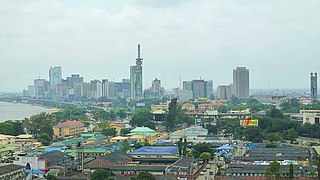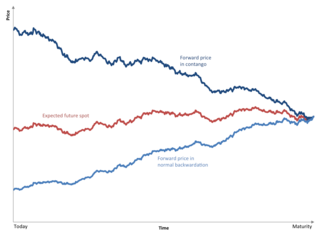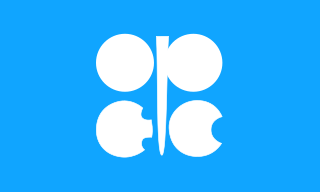Related Research Articles

The economy of Canada is a highly developed market economy. It is the 10th largest GDP by nominal and 16th largest GDP by PPP in the world. As with other developed nations, the country's economy is dominated by the service industry which employs about three quarters of Canadians. Canada has the third highest total estimated value of natural resources, valued at US$33.2 trillion in 2019. It has the world's third largest proven petroleum reserves and is the fourth largest exporter of petroleum. It is also the fourth largest exporter of natural gas. Canada is considered an "energy superpower" due to its abundant natural resources and a small population of 37 million inhabitants relative to its land area.

The economy of Nigeria is a middle-income, mixed economy and emerging market, with expanding manufacturing, financial, service, communications, technology and entertainment sectors. It is ranked as the 27th-largest economy in the world in terms of nominal GDP, and the 22nd-largest in terms of purchasing power parity. Nigeria has the largest economy in Africa; its re-emergent manufacturing sector became the largest on the continent in 2013, and it produces a large proportion of goods and services for the West African subcontinent. In addition, the debt-to-GDP ratio is 16.075 percent as of 2019.

A commodity market is a market that trades in the primary economic sector rather than manufactured products, such as cocoa, fruit and sugar. Hard commodities are mined, such as gold and oil. Investors access about 50 major commodity markets worldwide with purely financial transactions increasingly outnumbering physical trades in which goods are delivered. Futures contracts are the oldest way of investing in commodities. Futures are secured by physical assets. Commodity markets can include physical trading and derivatives trading using spot prices, forwards, futures, and options on futures. Farmers have used a simple form of derivative trading in the commodity market for centuries for price risk management.

Contango, also sometimes called forwardation, is a situation where the futures price of a commodity is higher than the spot price of the contract today. In a contango situation, arbitrageurs or speculators, are "willing to pay more [now] for a commodity [to be received] at some point in the future than the actual expected price of the commodity [at that future point]. This may be due to people's desire to pay a premium to have the commodity in the future rather than paying the costs of storage and carry costs of buying the commodity today." On the other side of the trade, hedgers are happy to sell futures contracts and accept the higher-than-expected returns. A contango market is also known as a normal market, or carrying-cost market.

The Organization of the Petroleum Exporting Countries is an intergovernmental organization of 13 nations, founded on 14 September 1960 in Baghdad by the first five members, and headquartered since 1965 in Vienna, Austria. As of September 2018, the 14 member countries accounted for an estimated 44 percent of global oil production and 81.5 percent of the world's "proven" oil reserves, giving OPEC a major influence on global oil prices that were previously determined by the so-called "Seven Sisters" grouping of multinational oil companies. A larger group called OPEC+ was formed in late 2016 to have more control on global crude oil market. Due to the COVID-19 pandemic the demand for OPEC oil has fallen to a 30-year low in second quarter of 2020.
The terms of trade (TOT) is the relative price of exports in terms of imports and is defined as the ratio of export prices to import prices. It can be interpreted as the amount of import goods an economy can purchase per unit of export goods.
The National Energy Program (NEP) was an energy policy of the Government of Canada from 1980 to 1985. It was created under the Liberal government of Prime Minister Pierre Trudeau by Minister of Energy Marc Lalonde in 1980, and administered by the Department of Energy, Mines and Resources.

Liquefied natural gas (LNG) is natural gas (predominantly methane, CH4, with some mixture of ethane, C2H6) that has been cooled down to liquid form for ease and safety of non-pressurized storage or transport. It takes up about 1/600th the volume of natural gas in the gaseous state (at standard conditions for temperature and pressure). It is odorless, colorless, non-toxic and non-corrosive. Hazards include flammability after vaporization into a gaseous state, freezing and asphyxia. The liquefaction process involves removal of certain components, such as dust, acid gases, helium, water, and heavy hydrocarbons, which could cause difficulty downstream. The natural gas is then condensed into a liquid at close to atmospheric pressure by cooling it to approximately −162 °C (−260 °F); maximum transport pressure is set at around 25 kPa (4 psi).

Peak oil is the theorized point in time when the maximum rate of extraction of petroleum is reached, after which it is expected to enter terminal decline. As of 2020, peak oil forecasts range from the early 2020s to the 2040s, depending on economics and how governments respond to global warming. It is often confused with oil depletion; however, whereas depletion refers to a period of falling reserves and supply, peak oil refers to the point of maximum production. The concept of peak oil is often credited to geologist M. King Hubbert whose 1956 paper first presented a formal theory. Peak oil occurs when the cost of oil extraction exceeds the price consumers will pay. Most early analyses concentrated on increasing costs of extraction and assumed that demand would drive costs higher. More recent analyses concentrate on drop in demand as alternatives to oil become more attractive.

Brent Crude is a trading classification of sweet light crude oil that serves as one of the two main benchmark prices for purchases of oil worldwide, the other being West Texas Intermediate. This grade is described as light because of its relatively low density, and sweet because of its low sulphur content. Brent Crude is extracted from the North Sea and comprises Brent Blend, Forties Blend, Oseberg and Ekofisk crudes. The Brent Crude oil marker is also known as Brent Blend, London Brent and Brent petroleum.
The Ministry of Energy is a Cabinet-level agency of the government of the Canadian province of Alberta responsible for coordinating policy relating to the development of mineral and energy resources. It is also responsible for assessing and collecting non-renewable resource (NRR) royalties, freehold mineral taxes, rentals, and bonuses. The Alberta Petroleum Marketing Commission, which is fully integrated with the Department of Energy within the ministry, and fully funded by the Crown, accepts delivery of the Crown's royalty share of conventional crude oil and sells it at the current market value.

The economy of the Middle East is very diverse, with national economies ranging from hydrocarbon-exporting rentiers to centralized socialist economies and free-market economies. The region is best known for oil production and export, which significantly impacts the entire region through the wealth it generates and through labor utilization. In recent years, many of the countries in the region have undertaken efforts to diversify their economies.

The price of oil, or the oil price, generally refers to the spot price of a barrel of benchmark crude oil—a reference price for buyers and sellers of crude oil such as West Texas Intermediate (WTI), Brent Crude, Dubai Crude, OPEC Reference Basket, Tapis crude, Bonny Light, Urals oil, Isthmus and Western Canadian Select (WCS). There is a differential in the price of a barrel of oil based on its grade—determined by factors such as its specific gravity or API gravity and its sulfur content—and its location—for example, its proximity to tidewater and refineries. Heavier, sour crude oils lacking in tidewater access—such as Western Canadian Select—are less expensive than lighter, sweeter oil—such as WTI.

Purchasing Managers' Indexes (PMI) are economic indicators derived from monthly surveys of private sector companies.
The nationalization of oil supplies refers to the process of confiscation of oil production operations and private property, generally in the purpose of obtaining more revenue from oil for oil-producing countries' governments. This process, which should not be confused with restrictions on crude oil exports, represents a significant turning point in the development of oil policy. Nationalization eliminates private business operations—in which private international companies control oil resources within oil-producing countries—and allows oil-producing countries to gain control of private property. Once these countries become the sole owners of these confiscated resources, they have to decide how to maximize the net present value of their known stock of oil in the ground. Several key implications can be observed as a result of oil nationalization. "On the home front, national oil companies are often torn between national expectations that they should 'carry the flag' and their own ambitions for commercial success, which might mean a degree of emancipation from the confines of a national agenda."

A stock index, or stock market index, is an index that measures a stock market, or a subset of the stock market, that helps investors compare current price levels with past prices to calculate market performance. It is computed from the prices of selected stocks.
Western Canadian Select (WCS) is one of North America's largest heavy crude oil streams. It is a heavy blended crude oil, composed mostly of bitumen blended with sweet synthetic and condensate diluents and 21 existing streams of both conventional and unconventional Alberta heavy crude oils at the large Husky Midstream General Partnership terminal in Hardisty, Alberta. Western Canadian Select—which is the benchmark for emerging heavy, low TAN (<1.1)(acidic) crudes— is one of many petroleum products from the Western Canadian Sedimentary Basin oil sands. WCS was launched in December 2004 as a new heavy oil stream by EnCana, Canadian Natural Resources Limited, Petro-Canada and Talisman Energy Inc.. Husky Energy joined the initial four Founders in 2015. Husky Energy sold 65% of their Midstream business in 2016 and formed the Husky Midstream General Partnership (HMGP) with two additional partners. HMGP exclusively blends the crude super-stream to ensure a consistent high quality heavy crude product that is demanded by refineries.
Jeff Currie is an economist and the Global Head of Commodities Research in the Global Investment Research Division at Goldman Sachs. He rose to prominence during the 2000s by forecasting the commodity super-cycle and oil spiking above $100 a barrel. He has been labelled a "maverick" for making bold calls that 'pack a punch'. More recently, he has been known for forecasting oil prices to stay lower for longer to end the shale supply glut.
The posted price of oil was the price that oil companies offered to purchase oil from oil-producing governments. This price was set by the oil companies and used to calculate the share of oil revenues that oil producing countries would receive. Between 1957 and 1972, the posted price was greater than the market price of crude oil. Between 1961 and 1970 the market price hovered between $1.30 and $1.50 per barrel, while the posted price was a constant $1.80.
References
- ↑ "Quantifying Political Risk". Oil&Gas Financial Journal. 2015-08-07. Retrieved 2015-09-26.
- ↑ "Nuclear Negotiations, Restructuring at Chevron and a New Political Risk Index for Oil Markets". Alberta Oil Magazine. 2015-06-29. Archived from the original on 2015-12-20. Retrieved 2015-09-26.
- ↑ "PRIX index Q3 indicates rising oil exports". Scandinavian Oil-Gas Magazine. 2015-07-01. Retrieved 2015-09-26.
- ↑ "An Anatomy of the Crude Oil Pricing System" (PDF). 2015-07-01. Retrieved 2015-09-26.
- ↑ "A Detailed Analysis Into the Fundamental Factors Affecting Crude Oil Prices" (PDF). Archived from the original (PDF) on 2015-11-17.